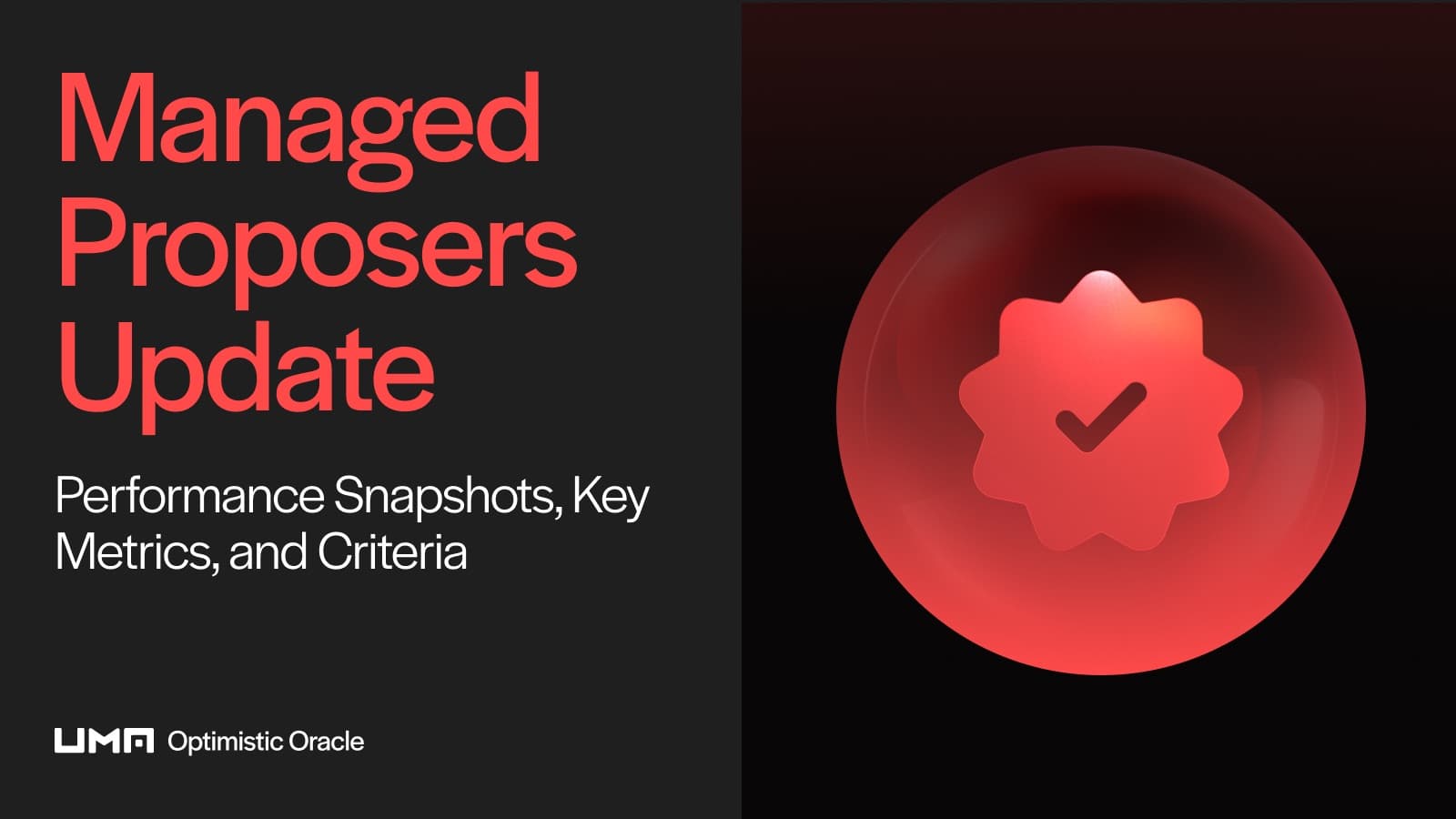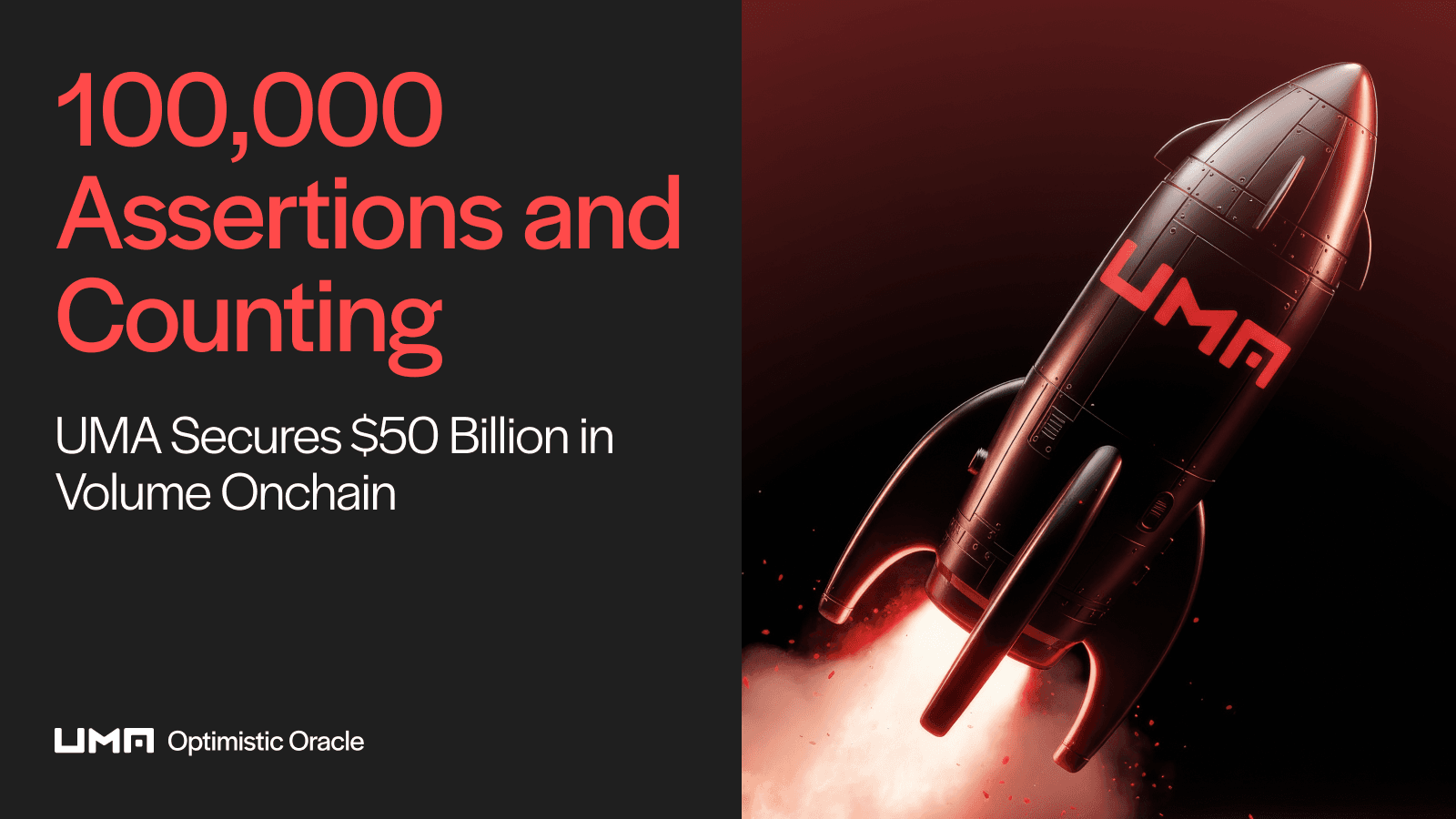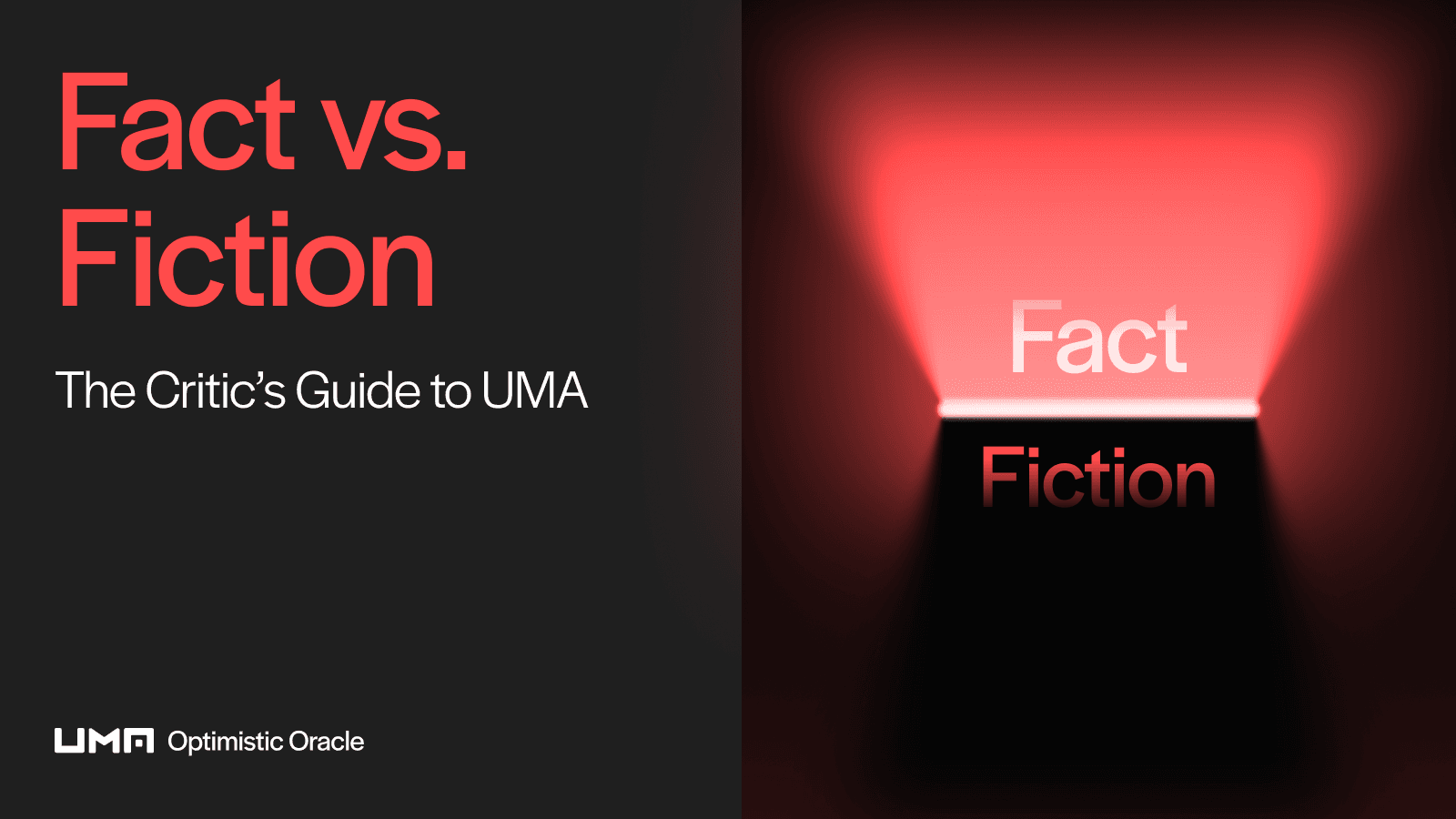The Future of IP is Programmable. UMA is Built to Secure It.
TLDR
The internet made copying easy. AI made it instant. But enforcing intellectual property rights hasn’t kept up, until now. Story and UMA are building the rails for programmable IP: a system where creators can license, monetize, and defend their work onchain, and where AI companies can access high-quality, licensed data by default. With Story’s licensing infrastructure and UMA’s decentralized dispute resolution, IP becomes usable, enforceable, and financeable at internet scale. This is the future of creative ownership, and it’s already live.
Introduction
Creativity is thriving, but ownership is at risk.
At any given second, hundreds of thousands of new pieces of content are being published online. AI is accelerating this pace, and traditional intellectual property (IP) enforcement simply can’t keep up.
In a world where machines can mimic your voice, your style, even your imagination, IP owners are losing control. Content is scraped, remixed, and republished by AI models with no credit, no payment, and no permission. We’ve made it easy to copy. We’ve made it profitable to remix. But we haven’t made it fair to create.
But what if we could rewrite the rules?
What Is Programmable IP?
Programmable IP is a transparent, onchain system for owning, licensing, and monetizing original work at the speed and scale of the modern internet.
In contrast to the traditional IP system, which relies on paper contracts, manual negotiations, and jurisdiction-bound enforcement, programmable IP is global, composable, and enforced by code. It gives IP owners the ability to define how their work can be used (e.g., commercially, non-commercially, remixable, time-bound, or otherwise) and allows others to license that work under those terms instantly.
With programmable IP, a song can license itself, a character can split revenue with its co-creators, and an AI model can pay for the data it trains on in real time. Licensing becomes an API. Attribution becomes automatic. Revenue sharing becomes native.
Why Programmable IP Matters
Estimated at around $80 trillion globally, intellectual property (IP) is one of the world’s most valuable but underutilized asset classes. Yet for most, IP is hard to register, harder to monetize, and nearly impossible to enforce. Copyright offices are slow. Legal systems are expensive. And in an AI-native world, the speed of infringement has far outpaced the tools built to protect against it.
The web made distribution global and instantaneous. Now, AI makes replication just as fast. Models are trained on everything from blog posts to beats to artwork, often scraped without consent or compensation. Once something enters the digital ether, it’s no longer clear who owns it, who can use it, or who should get paid.
And yet, the demand for original content is growing.
Brands, apps, games, and models are hungry for stories, visuals, soundtracks, characters, and ideas. On the other hand, the next major wave of demand is coming from AI companies. Models need licensed, high-quality datasets to train responsibly, and they need infrastructure that ensures contributors are compensated automatically. Story is becoming the licensed data layer for AI: an onchain registry of rights, provenance, and permissions built for machine-scale coordination.
What’s missing is a system that empowers creators by enabling them to license their work easily, track usage transparently, and get rewarded automatically.
That’s what programmable IP offers: a public, programmable layer for registering, licensing, monetizing, and defending original work. Just as DeFi turned finance into composable infrastructure, onchain IP turns culture into composable code.
The big shift? IP becomes an input and output of the internet itself. It can move, interact, and enforce its own rights across platforms. But building that vision requires infrastructure purpose-built for creativity. That's where Story comes in.

The Infrastructure Behind Programmable IP
The rise of programmable IP is about empowering IP owners. It’s also about unlocking the full value of the world’s most iconic intellectual property. That includes a massively underserved category: real-world data and content used to train AI.
Story is building the foundation to bring it all onchain. From the works of next-gen storytellers to globally recognized IP like BLACKPINK, Miley Cyrus, and Justin Bieber, Story’s mission is to make IP usable, licensable, and traceable by design.
At the core of this vision is a simple premise: anyone should be able to define how their work is used, get paid when it’s used, and resolve disputes when it’s misused. Story makes that possible, UMA makes it enforceable.
Story provides the infrastructure to register and manage IP natively onchain. UMA supplies the oracle system that verifies usage, settles disputes, and ensures the rules are enforced without the need for a legal team or central authority. Together, we form a new kind of IP stack that is programmable at the protocol layer, interoperable across the internet, and powerful enough to serve creators and AI companies alike.
In other words, Story and UMA are building an economy where originality isn’t just preserved. It’s programmable.
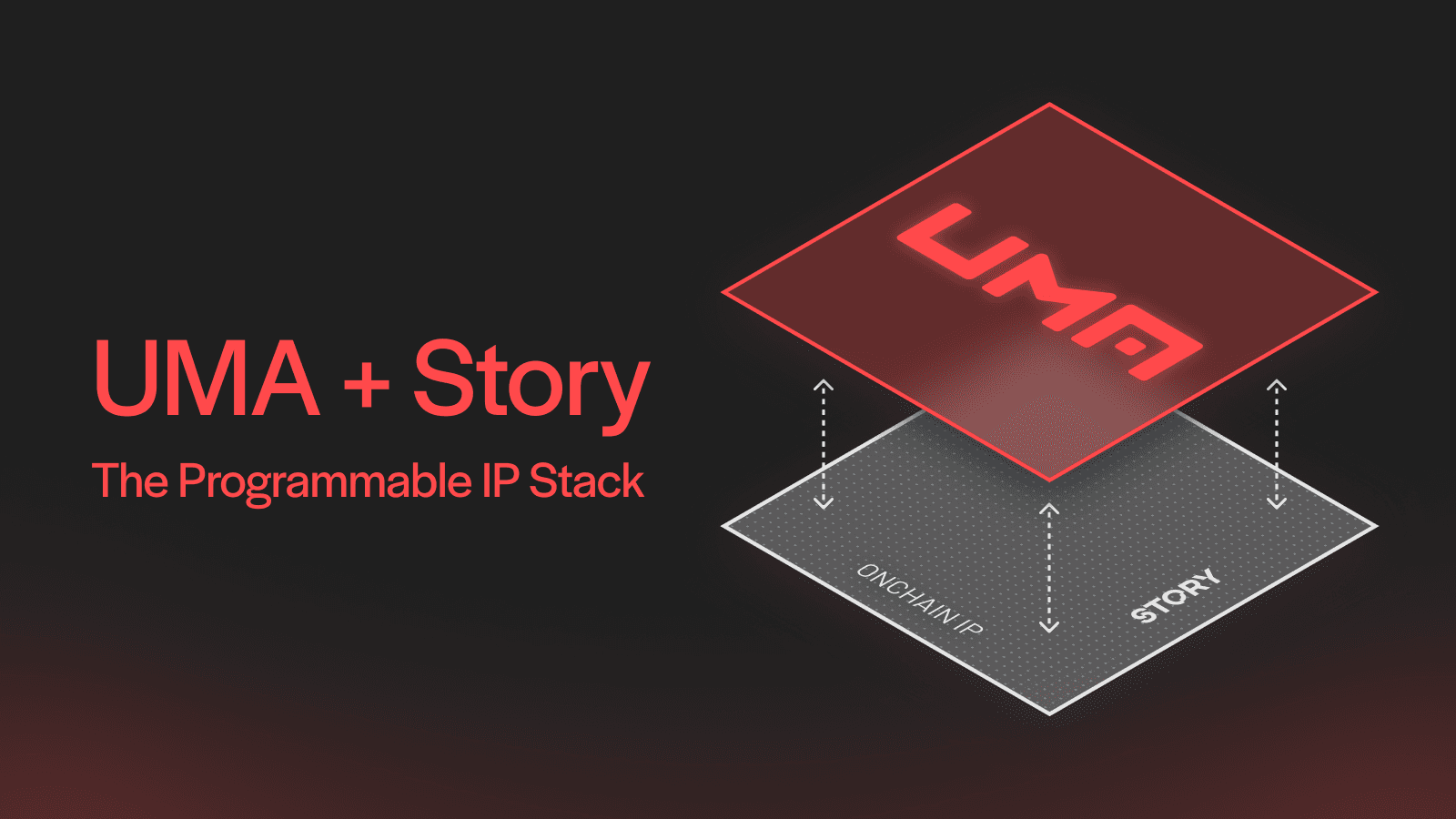
Story: Infrastructure for the Internet’s IP Economy
Story is a full-stack Layer 1 blockchain designed from the ground up for IP.
Where most chains are built for generic token transfer, Story is built for one thing: IP flow. That means it not only tracks ownership of content, it understands how content can be used, shared, extended, and monetized.
At the core of Story’s architecture is a set of primitives that treat IP like programmable assets:
1. IP Assets + Token-Bound Accounts (ERC-6551)
Each piece of content registered on Story (e.g., a story, image, dataset, song, or character) becomes an IP Asset, represented as an NFT. But unlike traditional NFTs, each IP Asset is bound to a smart contract wallet using ERC-6551, meaning it can hold assets, execute logic, and manage its own rights.
This makes IP “agentic.” Your story doesn’t just sit in a wallet. It can issue licenses, collect royalties, and enforce rules on its own.
2. Licensing Module
Story provides a modular licensing framework where users can publish standard, legally-enforceable licenses that define what others can do with their work. These licenses are programmable, as they exist onchain as smart contracts. But they’re also backed by real-world legal agreements via the Programmable IP License (PIL).
This dual-layer approach gives IP owners the best of both worlds: the automation of code and the enforceability of legal contracts.
3. Royalty Splitting and Derivatives
Story was designed with remix culture in mind. Its royalty module makes it easy to split revenue across contributors, collaborators, and upstream IP holders. If someone remixes your song or builds a spin-off of your character, the smart contract can automatically route a share of any resulting income back to you.
IP owners maintain control and gain leverage. Every derivative becomes a new stream of income.
4. The IP Graph
Story also tracks content lineage. When new assets are created from existing ones, that relationship is stored as a composable onchain graph. This means provenance is both preserved and a feature. Future licensing and monetization can reference this lineage to ensure attribution and revenue splits flow correctly, no matter how far downstream the derivative goes.
In short, Story makes IP programmable. But even with programmable licenses, there’s one thing smart contracts can’t do alone: verify whether the terms of those licenses were followed. That’s where UMA comes in.
UMA: Story’s Arbitration Layer for IP Disputes
You can automate license creation. You can automate royalty payments. But what about enforcement?
Let’s say a musician registers a song on Story and sets a commercial remix license at 10 $IP tokens. If someone remixes it without paying or violates the license terms, how do you prove it? How do you resolve that dispute in a decentralized, scalable way?
That’s exactly what UMA was designed for.
UMA provides the trustless arbitration layer for Story’s Dispute Module. It can verify intersubjective truths, not just asset prices. For example, it can resolve complex questions like:
“Did IP Asset #456 violate the license terms of IP Asset #123?”
“Was attribution provided in accordance with the agreed-upon license?”
“Does this derivative fall within the scope of allowed use?”
Because of this capability, UMA provides unmatched use cases and flexibility that other oracles simply cannot. Resolving onchain IP disputes happens to be one of those use cases.
How Story Uses UMA
Here is how Story uses UMA in practice:
1. A Dispute is Raised
A challenge is submitted through the Dispute Module. For example, an IP owner flags unauthorized usage. This action creates a corresponding assertion in UMA’s optimistic oracle and requires posting a bond.
2. Liveness Window Begins
A fixed "liveness" period starts, giving others time to respond:
First half: Only the IP owner can appeal.
Second half: Anyone can counter-dispute.
A counter-dispute also requires a matching bond and must include counter-evidence.
3. UMA Arbitration (if escalated)
If a counter-dispute is submitted, the dispute is escalated to UMA’s Data Verification Mechanism (DVM), where a decentralized and permissionless community of $UMA stakers evaluates the evidence and votes on whether the original claim is valid or not.
4. Resolution + Settlement
UMA's system finalizes the result and settles the assertion. The winning side gets their bond back plus half of the loser's side. The other half of the losing side's bond offsets UMA voting costs and effort.
Story uses the result to enforce the final outcome onchain.

This process is fast, decentralized, and modular. It replaces costly, subjective legal processes with a system of incentivized truth discovery, backed by crypto-economic guarantees. The result: IP enforcement that’s programmable, scalable, and credibly neutral.
And this isn’t theoretical. UMA is already used by protocols like Polymarket to resolve real-world questions. Now, it secures the internet’s IP layer too.
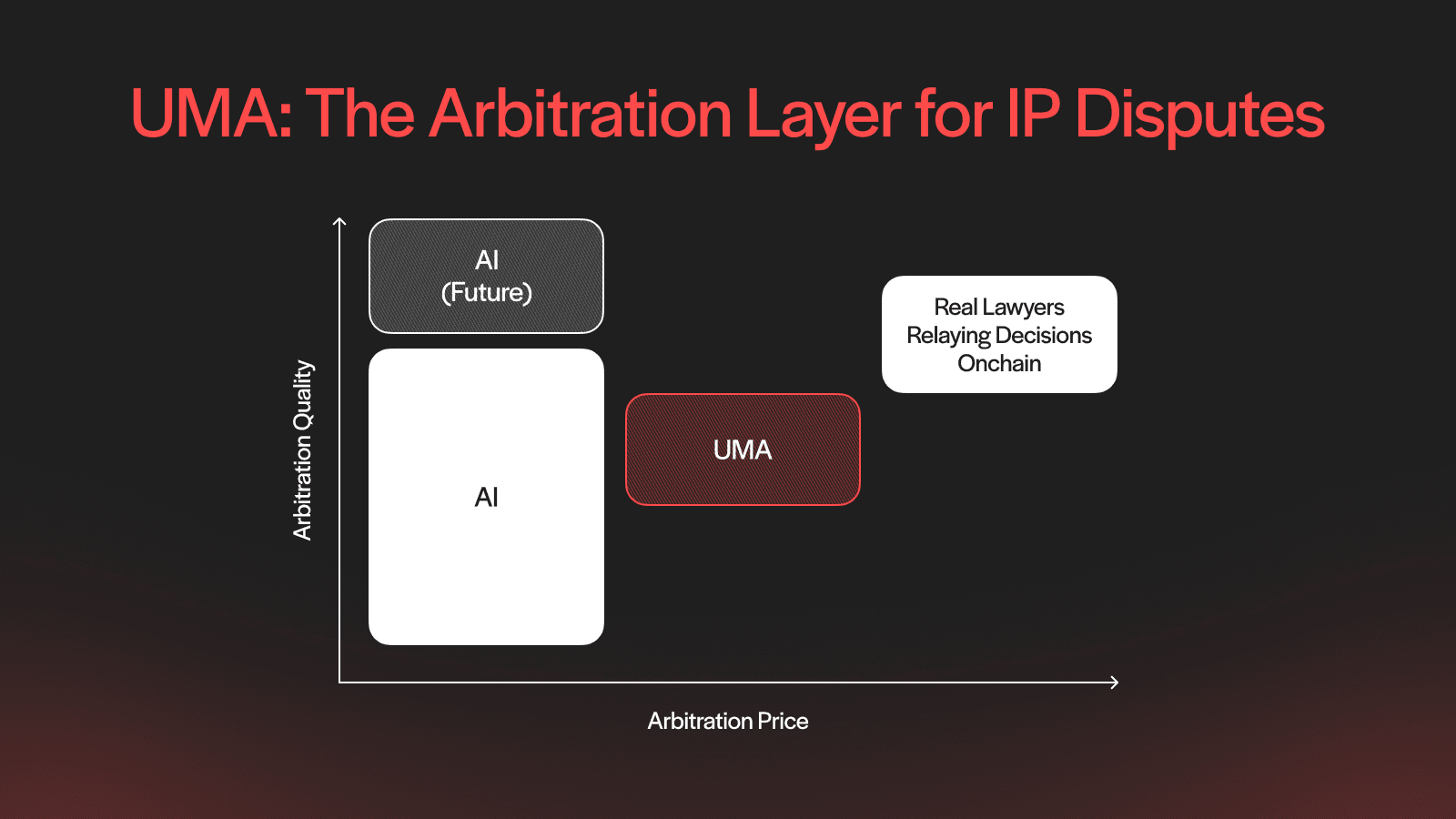
From IP to IPFi: A New Asset Class Emerges
When IP becomes programmable, it becomes financeable. That opens the door to an entirely new asset class: IPFi.
Just as real-world assets (RWAs) like real estate and invoices are coming onchain, intellectual property is being tokenized, collateralized, fractionalized, and plugged into the broader crypto economy.
Imagine:
A musician funding their next album by selling IP-backed tokens to fans, who receive a cut of streaming revenue.
A game developer licensing assets via smart contracts and routing payments to upstream builders instantly.
A DAO acquiring a portfolio of Story-registered characters and licensing them across platforms, with royalties split between tokenholders.
An AI model training on licensed data sets and paying contributors via real-time onchain micropayments, as pioneered by Mahojin.
Note that this is no longer hypothetical. Story and UMA’s dispute functionality are live. Mahojin is already compensating creators whose content is used to train AI models, without a middleman.
Story is becoming the substrate that powers permission-aware, royalty-enforced AI systems. As open and closed models search for ethically sourced training data, the protocol offers a programmable, onchain framework for licensing, attribution, and payment at scale.
Over time, we may see programmable IP flow into lending markets, insurance, derivatives, and index products. IP becomes liquid. Creators become capitalized. And the IP economy finally plugs into global liquidity.
What Happens Next?
The onchain IP movement is still early. But it’s no longer experimental. It’s infrastructural.
In the near future:
Iconic IP assets will be tokenized on Story, allowing anyone to earn from the IP they love.
AI companies may rely on Story as the go-to licensed data provider.
Web2 platforms may adopt Story as their backend, registering content by default while letting users opt into programmable licensing.
Governments and copyright offices may integrate with public registries to issue and recognize onchain rights.
AI agents may license training data on their own, paying IP owners automatically as part of the inference process.
Expert jurors or AI reviewers may participate in disputes, expanding the arbitration layer for IP enforcement.
New marketplaces will emerge, built on the assumption that IP is programmable and enforceable at the protocol layer.
But perhaps most importantly, we’ll see a cultural shift. IP owners will no longer have to choose between exposure and protection. They’ll no longer be forced to trust platforms with their livelihoods. They’ll be able to create, share, monetize, and defend their work on their terms with the help of smart contracts and decentralized oracles.
And in doing so, we’ll unlock a more open, collaborative, and composable IP economy; One where originality has leverage again.
Join the Movement
Want to join the onchain IP movement?
If you are a creator, start exploring how to register and license your IP with Story.
If you are a developer, integrate UMA’s optimistic oracle to resolve disputes in your protocol.
If you are a believer in open ecosystems, get involved and help spread the word. This is how we defend originality, preserve attribution, and open access to one of the biggest untapped markets: IP.
The tools are built. The rails are live. Are you ready?

